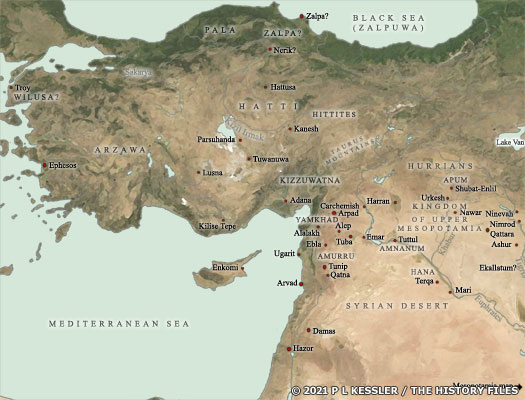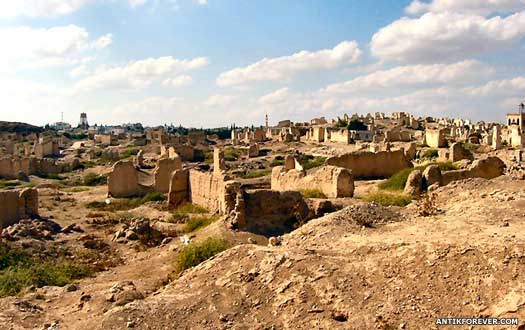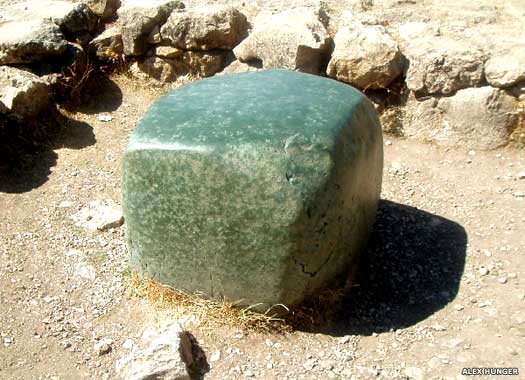
| QATNA / QATANUM Located in western central ancient Syria, to the south of Alep, stood the important Bronze Age city of Qatna (the modern archaeological mound known as Tell-el-Mishrife). It was located in the Wadi il-Aswad, a tributary of the Orontes, eighteen kilometres to the north-east of Homs.
In some records the city of Qatna is known as Nukhashshe or Nuhashe - although this seems more to refer to a fourteenth century BC confederation of cities of which Qatna may have been the most important. Its existence was first discovered by modern scholars in the Amarna letters, primarily those that had been sent to the Egyptian pharaoh from petty Syro-Palestinian kings. With remains that cover a square kilometre, it must have been one of the largest Bronze Age cities in western Syria. The site of Qatna was successfully linked with the present-day tell at Mishrife (or Mishrifeh) in 1927. The area around it is fertile, underlain by a bedrock of marly limestone over which several streams flow, forming a complex system of wadis. Most of these are now very small and the two main streams that flank the city are now dry for much of the year.
The city was occupied from the very beginning of the second millennium BC, probably by the very Amorites who had turned it into a small, independent state by the eighteenth century BC. For a long period in the early second millennium the city's most stubborn enemy was the state of Yamkhad, which was centred on Alep. Qatna, as a regionally-powerful kingdom in its own right, was more than able to hold its ground until the Late Bronze Age when its fortunes faded. Even then it remained politically well-connected and potentially influential.
(Information by Peter Kessler, with additional information from The Arzawa Letters in Recent Perspective, J David Hawkins (British Museum Studies in Ancient Egypt and Sudan 14 (73-83, 2009)), from The Cambridge Ancient History, edited by I E S Edwards, from Hittite Diplomatic Texts, Gary Beckman (Second Ed, Scholars Press, Atlanta, 1999), from The Kingdom of the Hittites, Trevor Bryce (1998), from The Hittites, O R Gurney (1991), from The Hittites, J G Macqueen (1996), from Qa?na and the Networks of Bronze Age Globalism, Frans Van Koppen (Peter Pfälzner (Ed), Proceedings of an International Conference in Stuttgart and Tübingen, October 2009, published 2015), and from External Link: The Last Kings of Qatna, Luigi Turri (Syria, Archaeology, Art, and History), and Qatna, Syria (World Archaeology, Issue 15, 2006).)
Although records are sketchy and imprecise, the Amorites of Babylon and other cities, such as Qatna, seem to emerge approximately a century after the collapse of Sumer when Babylon is freed from the domination of Kazallu. The first kings of Qatna are unknown, until one of two bearing the name of Amut-pi-el is mentioned as the immediate predecessor of Ishi-Addu. The city is at the height of its regional power by the latter's reign so it must be Amut-pi-el who lays the foundations for this success.
Small cities and minor states abounded in Syria at this time, while the Hittites were only just making an impact on the control of central Anatolia, and Mesopotamia was in recovery from the climate-induced social collapse of the end of the third millennium BC fl 1790s BC :
Amut-pi-el (I) : Amorite. First king known by name.
fl 1790s - 1770s BC :
Ishi-Addu : Son?
c.1790s - 1776 BC :
Ishi-Addu
is an ally (willing or otherwise) of Shamshi-Adad's kingdom of Upper
Mesopotamia. When that kingdom falls around 1776 BC, Qatna is restored
to full independence, and governs a number of towns, including Hazor
and many that are controlled by Amorites. However, it takes Hammurabi
of Babylon until about 1761 BC to fully conquer former Sumerian
Mesopotamia, but the importance of that conquest suggests that he
starts conquering Syrian city states almost as soon as the kingdom
of Upper Mesopotamia collapses. He is known to capture the city
of Qatna during his reign.
fl 1770s on BC :
Amut-pi-el (II) : Son. Former governor of Nazala.
c.1780s? BC :
The daughter of Amut-pi-el, Beltum, marries Yasmah-Adad of Mari. Another daughter, Dam-hurasim, later marries Zimri-Lim of Mari, successor to Yasmah-Adad. At this time Mari is a stable, prosperous city state which probably provides a key stopping point on a major trade route between Mesopotamia and Syria.
c.1765 BC :
The
ruler of Qatna, Amut-pi-el, offers his territory to Elam in order
to gain support in his conflict against what would seem to be a
long-standing enemy in the form of Yamkhad.
Following the conquest of Mari at the hands of the vengeful Hammurabi of Babylon, records concerning Qatna become sparse. Two years later Mari is sacked and devastated by Hammurabi and the region is incorporated into the Babylonian empire - Mari declines to the point at which it is little more than a village. The state of Yamkhad which is based at Alep now most certainly becomes Qatna's main opponent. Unfortunately, although Amut-pi-el would seemingly still be king, the loss of Mari's correspondence means that no further mention of him survives.
c.1761 BC :
Jahad-Abum : Son. Ruled?
c.1620s BC :
Yamkhad has become so powerful that it temporarily dominates Qatna under its ruler, Yarim-Lim III. However, as a result of its success it becomes a key target for attacks by the newly created Hittite kingdom to its north. They attack and destroy several of Yamkhad's vassals over several years, such as Alakhtum, Carchemish, and Hashshu, and the two states compete over Urkesh further east.
More complete than most ruins from this period, Qatna's street plan can still be clearly seen amidst some quite substantial wall remnants c.1595 BC :
In
the political collapse which follows the Hittite destruction of
Alep and the sacking of Babylon, the city of Qatna declines. By
the end of the century it is part of the Mitanni state which unifies
much of the region, lying on the border which forms disputed territory
between Mitanni and Egypt. Inscriptions on the Nin-Egal temple which
is part of the royal palace shows that Mitanni maintains a presence
in the city, but there is also an Egyptian influence there.
Napilima : Ruled Qatna.
fl c.1410s? BC :
A
list of gifts to the gods of Qatna mentions Idanda, Addu-Nirari
(both below), and Napilimi, who predates both of them. No dating
is available but an assumption can be made that they are part of
a series of rulers of Qatna around this time.
c.1410s - 1360s BC :
Addu-Nirari : Egyptian vassal king. Ruler of Qatna for at least 45 years.
c.1370s? BC :
According
to a text which has been dated to the time of Addu-Nirari, in this
period Qatna's territory reaches the Lebanon Mountains to the south-west.
Southwards it is probably bounded by another natural frontier, the
forest of Lebo which is mentioned in several Late Bronze Age texts.
The mouth of the Beqa Valley, south of Qadesh, is sparsely populated
even today, and it is plausible that the valley in the second millennium
BC area is either largely uninhabited or is occupied by nothing
more than nomads.
To the north, the kingdom reaches at least al-Rastan, Tunip, and Zinzar (if the latter two sites correspond to modern Asharne and Qalat Shayzar), with the possibility that even Hama is included in its domains if the Amata of a text found in Qatna's Lower City Palace can be equated with the Iron Age Hamath. This territory, along with that of some allies, could form the supposed confederation of Nuhashe which exists at this time. The confederation is seemingly dissolved when Addu-Nirari is defeated by Suppiluliuma after refusing to ally himself with the Hittite king.
fl c.1360s BC :
Idanda : Vassal king of Mitanni? Removed or succeeded by Taku.
c.1360s BC :
Cuneiform tablets found by archaeologists in AD 2002 under the royal palace reveal a previously unknown ruler of Qatna at this time - one Idanda, son of Ulashuddu. He comes late to the throne, having been active in the city's politics for almost thirty years (his name exists on the lists of gifts to the deities). Addu-Nirari's fate is unknown, but old age may have been a factor.
The green cubic stone at Hattusa was probably a gift to the Hittite rulers of the city from the Egyptian pharaoh with whom they signed a peace treaty in 1258 BC - by which time Qatna seems already to have been destroyed during their battles for control of Syria The city is currently dominated by Mitanni, and a Mitanni which is still very strong but which is no longer quite so aggressively all-conquering as it once had been. Perhaps client kings are allowed to govern this border city which is now constantly threatened by the Hittites and an unstable political situation in Syria, but Idanda is seemingly installed as a vassal of the Hittites. The political situation is certainly confused at this time, and allegiances shift rapidly. Egypt still has more than enough power in the region to install its own client king in Idanda's place.
fl c.1360s BC :
Taku / Takuwa : Vassal king installed by Egypt.
fl c.1340s BC :
Akizzi : Egyptian vassal king. Known from Amarna letters.
c.1340s BC :
Mitanni
is now split by a dynastic struggle and is in no position to defend
its outlying borders. The Hittite king, Suppiluliuma I, campaigns
again in Syria, and Qatna is one of a number of cities which are
captured and plundered. Qatna's ruler, Akizzi (whose reign can be
dated to the same period as that of Etakama of Qadesh), asks Egypt
for help but none is forthcoming while that country is in the midst
of its monotheistic reforms. Qatna's populace is transported to
Hatti, but the city apparently remains occupied (although perhaps,
given the next event, this takes place after the reign of Tette,
however long or short that may be).
fl c.1340s? BC :
Tette : Largely unknown. Ruled very briefly, perhaps?
c.1340s BC :
Qatna is seemingly destroyed around this time, most probably by the Hittites, although Emar records that Qatna is attacked by Aramaeans in the thirteenth century BC. Either way the city subsequently loses its significance as the trade routes switch to nearby Homs. While still occupied into the sixth century BC, it never regains any level of importance and is eventually abandoned entirely.
Source :
https://www.historyfiles.co.uk/ |


